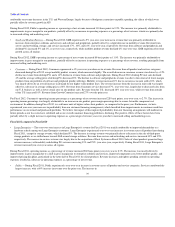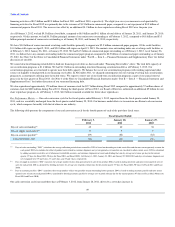Dell 2011 Annual Report Download - page 47
Download and view the complete annual report
Please find page 47 of the 2011 Dell annual report below. You can navigate through the pages in the report by either clicking on the pages listed below, or by using the keyword search tool below to find specific information within the annual report.
Table of Contents
Income and Other Taxes
Our effective tax rate was 17.6%, 21.3%, and 29.2% for Fiscal 2012, Fiscal 2011, and Fiscal 2010, respectively. The decrease in our effective income tax rate
for Fiscal 2012 as compared to Fiscal 2011, was primarily due to an increase in the proportion of taxable income attributable to lower tax jurisdictions. Our
effective tax rate can fluctuate depending on the geographic distribution of our world-wide earnings, as our foreign earnings are generally taxed at lower rates
than in the U.S. In certain jurisdictions, our tax rate is significantly less than the applicable statutory rate as a result of tax holidays. The majority of our
foreign income that is subject to these tax holidays and lower tax rates is attributable to Singapore, China, and Malaysia. Our significant tax holidays expire in
whole or in part during Fiscal 2016 through 2021. The differences between our effective tax rate and the U.S. federal statutory rate of 35% principally resulted
from the geographical distribution of taxable income discussed above and permanent differences between the book and tax treatment of certain items. We
continue to assess our business model and its impact in various taxing jurisdictions.
Deferred tax assets and liabilities are recorded for the estimated tax impact of temporary differences between the tax and book basis of assets and liabilities,
and are recognized based on the enacted statutory tax rates for the year in which we expect the differences to reverse. A valuation allowance is established
against a deferred tax asset when it is more likely than not that the asset or any portion thereof will not be realized. Based upon all the available evidence,
including expectation of future taxable income, we have determined that we will be able to realize all of our deferred tax assets, net of valuation allowances.
For a further discussion regarding tax matters, including the status of income tax audits, see Note 11 of the Notes to Consolidated Financial Statements
included in “Part II — Item 8 — Financial Statements and Supplementary Data.”
ACCOUNTS RECEIVABLE
We sell products and services directly to customers and through a variety of sales channels, including retail distribution. Our Accounts receivable, net was
$6.5 billion as of February 3, 2012, and January 28, 2011. We maintain an allowance for doubtful accounts to cover receivables that may be deemed
uncollectible. The allowance for losses is based on specific identifiable customer accounts that are deemed at risk and a provision for accounts that are
collectively evaluated based on historical bad debt experience. As of February 3, 2012, and January 28, 2011, the allowance for doubtful accounts was $63
million and $96 million, respectively. Based on our assessment, we believe we are adequately reserved for expected credit losses. We monitor the aging of our
accounts receivable and continue to take actions to reduce our exposure to credit losses.
DELL FINANCIAL SERVICES AND FINANCING RECEIVABLES
DFS offers a wide range of financial services, including originating, collecting, and servicing customer receivables primarily related to the purchase of Dell
products. To support the financing needs of our customers internationally, we have aligned with a select number of third-party financial services companies.
During Fiscal 2012, we acquired Dell Financial Services Canada Limited ("DFS Canada") from CIT Group Inc. In addition, we announced our entry into a
definitive agreement to acquire CIT Vendor Finance's Dell-related financing assets portfolio and sales and servicing functions in Europe for approximately
$400 million. Subject to customary closing, regulatory, and other conditions, Dell expects to close substantially all of this acquisition in the fiscal year ending
February 1, 2013. CIT Vendor Finance is currently a Dell financing preferred vendor operating in more than 25 countries and will continue to support Dell for
the transition period in Europe. CIT Vendor Finance will also continue to provide financing programs with Dell in select countries around the world,
including programs in Latin America, after completion of this transaction.
At February 3, 2012, and January 28, 2011, our net financing receivables balances were $4.7 billion and $4.4 billion, respectively. Included in the February 3,
2012, balance was approximately $0.3 billion related to our acquisition of the DFS Canada portfolio. To manage the expected net growth in financing
receivables, we will continue to balance the use of our own working capital and other sources of liquidity, including securitization programs.
We have securitization programs to fund revolving loans and fixed-term leases and loans through consolidated special purpose entities ("SPEs"), which we
account for as secured borrowings. We transfer certain U.S. customer financing receivables to these SPEs, whose purpose is to facilitate the funding of
customer receivables through financing arrangements with multi-seller conduits that issue asset-backed debt securities in the capital markets. We transferred
$2.3 billion, $1.9 billion, and $0.8 billion to these SPEs during Fiscal 2012, Fiscal 2011, and Fiscal 2010, respectively. Our risk of loss related to these
securitized receivables is limited to the amount of our over-collateralization in the transferred pool of receivables. At February 3, 2012, and January 28, 2011,
the structured financing debt related to all of our secured borrowing securitization programs was $1.3 billion and $1.0 billion, respectively, and the carrying
amount of the corresponding financing receivables was $1.5 billion and
45
























